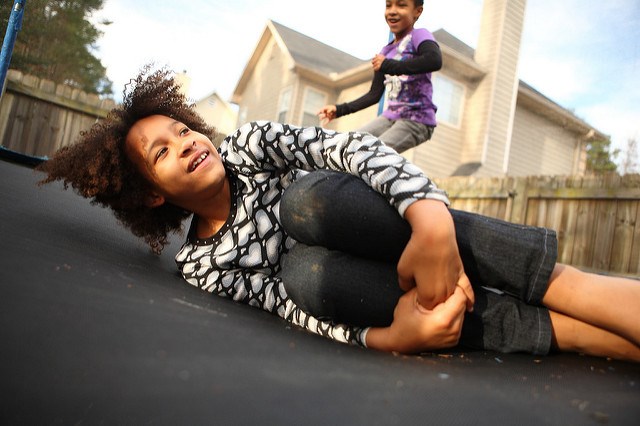The sun is out and, for many families in Squamish, so too is the backyard trampoline.
It’s also a busy time for Vancouver Coastal Health, tending to trampoline-related accidents.
In a recent news release VCH said, “We see hundreds of kids every year in hospital emergency departments with injuries from trampolines.”
Rodney Wilson, owner of Squamish trampoline centre Airhouse, told The Chief his own sister broke her arm on a backyard trampoline.
Wilson explained that it’s easy to roll your ankle from not warming up properly. Broken arms and wrists are also common, as are bumps and bruises from falling through the springs, he said.
“The most worrying thing for me though is really young kids going on trampolines prematurely.”
Airhouse’s policy is that children under three years old aren’t allowed to bounce.
But at home, that’s not always monitored.
“When you are under three, your head is proportionally larger than the rest of your body and it’s also heavier, so you’re more susceptible to head and neck injuries if you get off-balance,” said Wilson.
His second biggest worry is having more than one child on the trampoline at the same time – a factor that accounts for 80 per cent of all trampoline injuries, according to stats from the Canadian Hospitals Injury Reporting and Prevention Program.
“If someone who is 100lbs jumps up and lands on the trampoline, it pulls back with just as much force. That’s the rebounding action. A 30lb or 40lb child using the trampoline at the same time then gets their own force and that of the heavier person because the trampoline is just giving back whatever energy is pushed in. If the timing isn’t right, you can be coming down while the trampoline is driving their weight up and your ligaments and tendons just buckle, and legs, knees and angles snap.”
Also, explained Tanya Liquorish, competitive trampoline coach, when more than one child is on the trampoline, the littlest one can experience ‘double bouncing’ and be rebounded far higher into the air.
“It can be funny at first but then it gets out of hand, she said.
“Having little kids and older ones on the trampoline at the same time is just a recipe for disaster.”
Both Liquorish and Wilson agreed that jumping on a trampoline has huge health benefits, but the equipment needs to be used properly with all the necessary precautions.
“Make sure the frame is level and on firm ground, that the springs and hooks are in place and facing the right direction, and that the frame pads are fixed in position,” said Wilson.
Another factor and one that is often overlooked is the condition of the surface of the trampoline, he said.
“A small hole can quickly rip,” and he added that adults should regularly check the condition of the springs, pads and bed.
Always choose a trampoline with a net, explained Liquorish, who’s seen spinal injuries from children who’ve fallen off backyard trampolines. “The kids can fall off and can scorpion. It’s terrible. Just so bad.”
The brightness of the sun and the wind should also be taken into consideration when trampolining outdoors, explained Wilson.
In addition to always monitoring a child on a trampoline, another important thing parents can do, explained both Wilson and Liquorish, is to equip children with some basic training before allowing them to bounce, especially in how to fall safely.
“You wouldn’t throw your kids into a pool before they could swim, so don’t let them on to a trampoline without lessons from a good coach first,” she said. “Kids love trampolining. It’s exercise, it’s outside, it’s off the iPad. I’m all for it. They just need to know how to do it safely.”




